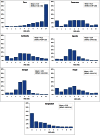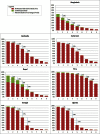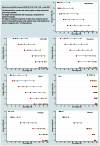Patterns and determinants of antenatal care utilization: analysis of national survey data in seven countdown countries
- PMID: 27231540
- PMCID: PMC4871063
- DOI: 10.7189/jogh.06.010404
Patterns and determinants of antenatal care utilization: analysis of national survey data in seven countdown countries
Abstract
Background: Antenatal care (ANC) is critical for improving maternal and newborn health. WHO recommends that pregnant women complete at least four ANC visits. Countdown and other global monitoring efforts track the proportions of women who receive one or more visits by a skilled provider (ANC1+) and four or more visits by any provider (ANC4+). This study investigates patterns of drop-off in use between ANC1+ and ANC4+, and explores inequalities in women's use of ANC services. It also identifies determinants of utilization and describes countries' ANC-related policies, and programs.
Methods: We performed secondary analyses using Demographic Health Survey (DHS) data from seven Countdown countries: Bangladesh, Cambodia, Cameroon, Nepal, Peru, Senegal and Uganda. The descriptive analysis illustrates country variations in the frequency of visits by provider type, content, and by household wealth, women's education and type of residence. We conducted a multivariable analysis using a conceptual framework to identify determinants of ANC utilization. We collected contextual information from countries through a standard questionnaire completed by country-based informants.
Results: Each country had a unique pattern of ANC utilization in terms of coverage, inequality and the extent to which predictors affected the frequency of visits. Nevertheless, common patterns arise. Women having four or more visits usually saw a skilled provider at least once, and received more evidence-based content interventions than women reporting fewer than four visits. A considerable proportion of women reporting four or more visits did not report receiving the essential interventions. Large disparities exist in ANC use by household wealth, women's education and residence area; and are wider for a larger number of visits. The multivariable analyses of two models in each country showed that determinants had different effects on the dependent variable in each model. Overall, strong predictors of ANC initiation and having a higher frequency (4+) of visits were woman's education and household wealth. Gestational age at first visit, birth rank and preceding birth interval were generally negatively associated with initiating visits and with having four or more visits. Information on country policies and programs were somewhat informative in understanding the utilization patterns across the countries, although timing of adoption and actual implementation make direct linkages impossible to verify.
Conclusion: Secondary analyses provided a more detailed picture of ANC utilization patterns in the seven countries. While coverage levels differ by country and sub-groups, all countries can benefit from specific in-country assessments to properly identify the underserved women and the reasons behind low coverage and missed interventions. Overall, emphasis needs to be put on assessing the quality of care offered and identifying women's perception to the care as well as the barriers hindering utilization. Country policies and programs need to be reviewed, evaluated and/or implemented properly to ensure that women receive the recommended number of ANC visits with appropriate content, especially, poor and less educated women residing in rural areas.
Figures





References
-
- United Nations. Framework of actions for the follow–up to the Programme of Action of the International Conference on Population and Development Beyond 2014. United Nations, 2014.
-
- United States Agency for International Development. Ending preventable maternal mortality: USAID maternal health vision for action – Evidence for strategic approaches. Washington DC: USAID, 2015.
-
- Lincetto O, Mothebesoane–Anoh S, Gomez P, Munjanja S, Munjanja S. Chapter 2: Antenatal care In: Lawn J, Kerber K, editors. Opportunities for Africa's Newborns: practical data, policy and programmatic support for newborn care in Africa. Geneva: World Health Organization; 2006. p. 51–62.
-
- World Health Organization. Standards for maternal and neonatal care. Geneva: World Health Organization; 2007.
-
- World Health Organization. Pregnancy, childbirth, postpartum and newborn care: a guide for essential practice. Report No.: 3rd edition. Geneva: WHO, 2015. 1–184 p. - PubMed
Publication types
MeSH terms
LinkOut - more resources
Full Text Sources
Other Literature Sources
Medical
